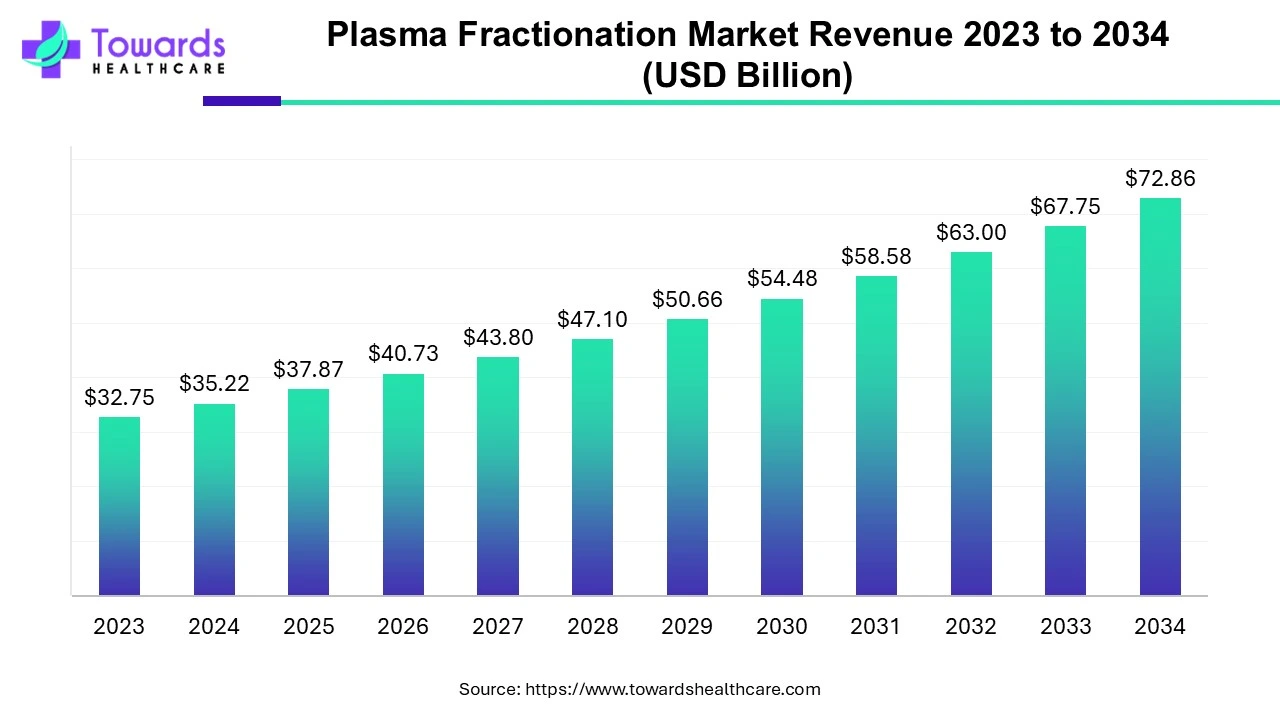December 2024


Principal Consultant

Reviewed By
The global plasma fractionation market size was estimated at US$ 32.75 billion in 2023 and is projected to grow to US$ 72.86 billion by 2034, rising at a compound annual growth rate (CAGR) of 7.54% from 2024 to 2034. The rising therapeutic demand for plasma is boosting the plasma fractionation market.

Plasma fractionation is a complex process to separate blood plasma into individual components, predominantly protein which includes clotting factors, albumin, immunoglobulins and fibrinogens, other components are enzymes and antibodies with phenomenal therapeutical values. Plasma fractionation is widely used in pharmaceutical research to treat chronic diseases. The worldwide rising demand for plasma derivatives due to increased immune disease, coagulation disorders and genetic defects is fuelling the market growth.
The chromatography-based method for plasma separation rapidly gaining popularity as offers gradual improvement, improves purity and enables the production of new classes of therapeutics. Plasma contains over 120 varieties of protein. When these proteins are extracted pure and concentrated, they can create life-saving therapeutics which are crucial for the treatment of several diseases such as immune deficiencies and bleeding disorders.
Even today, modern plasma fractionation technology relies on the original, ethanol-based protocol which is mostly used to isolate albumin. To produce novel plasma products which can be used to treat protein deficiencies, it is essential to implement chromatographic techniques. This precise technique has the ability to capture even trace protein. With the help of ion-exchange chromatography (IEC), proteins at their original pH and ionic strength, even fragile proteins (such as coagulation factors, anticoagulants, and protease inhibitors) are preserved and isolated.
A study published in the journal Science Translational Medicine mentions a pattern developing with certain blood plasma protein levels that can lead to the development of sepsis in patients. A team of medical researchers analysed the plasma profiles of hundreds of ICU patients who had developed sepsis. When the body shows dysregulated response to infection, it the known as sepsis condition. It is considered a life-threatening condition as it leads to multiple organ failure. Every year in the United Kingdom approximately 50,000 deaths are noted due to sepsis.
The researchers drew out plasma samples from 16,000 patients and measured protein levels for plasma proteome using tandem mass spectrometry and liquid chromatography on 2,600 samples. The results provide a general profile which is used to identify patients at risk.
North America dominated the global plasma fractionation market in 2023. The unites states is the largest supplier of Plasma Fractionation in the world. As US has a policy of paid donors while other countries obtain plasma from volunteers and unpaid donors. Therefore, the rate of plasma collection is less in other countries. Canadian Blood Service uses raw plasma to produce a category of drugs such as plasma protein and related products. Additionally, the three largest plasma product companies in the U.S. – CSL Plasma, Grifols and BioLife, collect over 75% of total plasma for fractionation in the States. That are about 54% more plasma donation centres in the US than there were four years back. With the rising demand for plasma on every basis of 6,500 units, there needs to be a consistent donation rate.
Europe is anticipated to register the fastest growth in the haptic devices market during the forecast period of 2024 to 2034. The growth in this region depends upon the European Union's attainment of open strategic autonomy and improved competitiveness. European Union institutes, governments and businesses are working towards a better understanding of potential vulnerabilities and opportunities to modify policies to ensure a resilient supply of plasma and plasma-derived medicinal products. This action will provide a better solution for the EU and national level to achieve recognition.
By type, Immune Globulin dominated the plasma fractionation market in 2023. The growth of this segment is noticed by plasma-derived immunoglobulins are provided with a new narrative in the healthcare industry for a wide range of autoimmune inflammatory diseases. Immune globulin is needed for a patient who cannot make enough antibodies. This provides externally sourced antibodies for recovery.
The Coagulation Factor segment is expected to grow significantly in the plasma fractionation market during the forecast period of 2024 to 2034. The expansion of this segment is observed due to its ability to stop bleeding when injured. It includes a system of proteins that controls the conversion of soluble plasma fibrinogen to fibrin, an insoluble polymer that forms a gel network to stop bleeding.
By application, the hospital segment stood dominant in the plasma fractionation market in 2023. The dominance is observed due to the wide utilization of plasma at hospitals for emergency cases to boost blood volume in trauma patients, prevent shock and help with blood clotting. Healthcare providers supply various plasma-derived medicinal products to hospitals and other healthcare facilities for the treatment of patients with immune deficiency disorders, immunodeficiency virus, hepatitis virus and many more.
The retail pharmacy segment is anticipated to grow with the highest CAGR in the plasma fractionation market during the studied years. Pharmaceutical companies extract components from raw human plasma using centrifugation, depth filtration and chromatographic methods. The manufacturing process is carried out to produce effective and safe drugs.
By Type
By Application
By Region
December 2024
December 2024
November 2024
October 2024